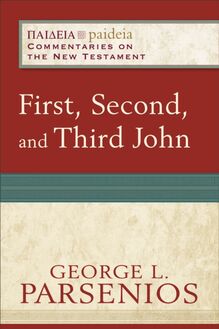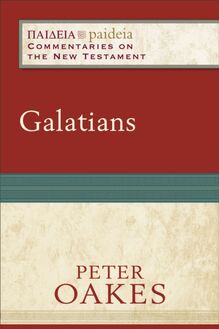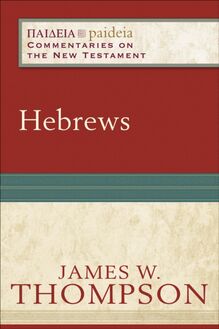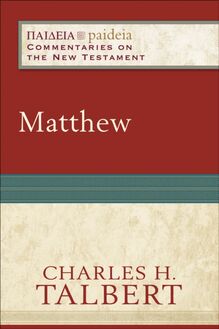-
 Univers
Univers
-
 Ebooks
Ebooks
-
 Livres audio
Livres audio
-
 Presse
Presse
-
 Podcasts
Podcasts
-
 BD
BD
-
 Documents
Documents
-
- Cours
- Révisions
- Ressources pédagogiques
- Sciences de l’éducation
- Manuels scolaires
- Langues
- Travaux de classe
- Annales de BEP
- Etudes supérieures
- Maternelle et primaire
- Fiches de lecture
- Orientation scolaire
- Méthodologie
- Corrigés de devoir
- Annales d’examens et concours
- Annales du bac
- Annales du brevet
- Rapports de stage
La lecture à portée de main
Vous pourrez modifier la taille du texte de cet ouvrage
Découvre YouScribe en t'inscrivant gratuitement
Je m'inscrisJames and Jude (Paideia: Commentaries on the New Testament) , livre ebook
Découvre YouScribe en t'inscrivant gratuitement
Je m'inscrisEn savoir plus
Vous pourrez modifier la taille du texte de cet ouvrage
En savoir plus

Description
Sujets
Informations
| Publié par | Baker Publishing Group |
| Date de parution | 15 novembre 2012 |
| Nombre de lectures | 0 |
| EAN13 | 9781441240385 |
| Langue | English |
Informations légales : prix de location à la page 0,0864€. Cette information est donnée uniquement à titre indicatif conformément à la législation en vigueur.
Extrait
G ENERAL E DITORS
Mikeal C. Parsons and Charles H. Talbert
A DVISORY B OARD
Paul J. Achtemeier
Loveday Alexander
C. Clifton Black
Susan R. Garrett
Francis J. Moloney
James © 2012 by John Painter Jude © 2012 by David A. deSilva
Published by Baker Academic a division of Baker Publishing Group PO Box 6287, Grand Rapids, MI 49516-6287 www.bakeracademic.com
Ebook edition created 2012
All rights reserved. No part of this publication may be reproduced, stored in a retrieval system, or transmitted in any form or by any means for example, electronic, photocopy, recording without the prior written permission of the publisher. The only exception is brief quotations in printed reviews.
ISBN 978-1-4412-4038-5
Library of Congress Cataloging-in-Publication Data is on file at the Library of Congress, Washington, DC.
All quotations from James and Jude are the authors’ own translations. Scripture quotations labeled NRSV are from the New Revised Standard Version of the Bible, copyright © 1989, by the Division of Christian Education of the National Council of the Churches of Christ in the United States of America. Used by permission. All rights reserved.
For DWBR in gratitude and with thanks J. P. In honor of N. Clayton Croy, a reliable friend, meticulous scholar, and faithful Christ-follower D. A. deS.
Contents
Cover
Series Page
Title Page
Copyright Page
Dedication
List of Figures and Tables
Foreword
Abbreviations
James
Preface to James
Introduction to James
James 1:1: Address/Salutation
James 1:2–27: Epitome of the Exhortation of James
James 2:1–13: Warning against Partiality
James 2:14–26: Faith and Works
James 3:1–12: The Tongue
James 3:13–4:10: God and the World
James 4:11–5:6: Admonitions and Warnings
James 5:7–20: Concluding Pastoral Advice
Jude
Preface to Jude
Introduction to Jude
Jude 1–4: Letter Opening
Jude 5–10: Intruders’ Behavior Illumined from History
Jude 11–15: Intruders’ Behavior Illumined from History, Nature, and Prophecy
Jude 16–25: Exhortations and Conclusion
Bibliography
Index of Subjects
Index of Modern Authors
Index of Scripture and Ancient Sources
Notes
Back Cover
Figures and Tables
Figures
1. James/Jacob Ossuary Inscription
2. Map of the Jewish Diaspora in the First Century CE
3. Structural Diagram of the Epistle of James
4. Ancient Ship’s Rudder
5. Tongues of Fire at Pentecost
6. The Garden of Eden with the Fall of Man
7. 𝔓 78 Showing Jude 4–5 and 7–8
8. Cain Killing Abel
Tables
1. Vocabulary Shared between James and Matthew
2. Themes Shared between James and the Synoptic Gospels
3. Intratextual Relationships in James
Foreword
Paideia: Commentaries on the New Testament is a series that sets out to comment on the final form of the New Testament text in a way that pays due attention both to the cultural, literary, and theological settings in which the text took form and to the interests of the contemporary readers to whom the commentaries are addressed. This series is aimed squarely at students including MA students in religious and theological studies programs, seminarians, and upper-division undergraduates who have theological interests in the biblical text. Thus, the didactic aim of the series is to enable students to understand each book of the New Testament as a literary whole rooted in a particular ancient setting and related to its context within the New Testament.
The name “Paideia” (Greek for “education”) reflects (1) the instructional aim of the series giving contemporary students a basic grounding in academic New Testament studies by guiding their engagement with New Testament texts; (2) the fact that the New Testament texts as literary unities are shaped by the educational categories and ideas (rhetorical, narratological, etc.) of their ancient writers and readers; and (3) the pedagogical aims of the texts themselves their central aim being not simply to impart information but to form the theological convictions and moral habits of their readers.
Each commentary deals with the text in terms of larger rhetorical units; these are not verse-by-verse commentaries. This series thus stands within the stream of recent commentaries that attend to the final form of the text. Such reader-centered literary approaches are inherently more accessible to liberal arts students without extensive linguistic and historical-critical preparation than older exegetical approaches, but within the reader-centered world the sanest practitioners have paid careful attention to the extratext of the original readers, including not only these readers’ knowledge of the geography, history, and other contextual elements reflected in the text but also their ability to respond correctly to the literary and rhetorical conventions used in the text. Paideia commentaries pay deliberate attention to this extratextual repertoire in order to highlight the ways in which the text is designed to persuade and move its readers. Each rhetorical unit is explored from three angles: (1) introductory matters; (2) tracing the train of thought or narrative or rhetorical flow of the argument; and (3) theological issues raised by the text that are of interest to the contemporary Christian. Thus, the primary focus remains on the text and not its historical context or its interpretation in the secondary literature.
Our authors represent a variety of confessional points of view: Protestant, Catholic, and Orthodox. What they share, beyond being New Testament scholars of national and international repute, is a commitment to reading the biblical text as theological documents within their ancient contexts. Working within the broad parameters described here, each author brings his or her own considerable exegetical talents and deep theological commitments to the task of laying bare the interpretation of Scripture for the faith and practice of God’s people everywhere.
Mikeal C. Parsons Charles H. Talbert
Abbreviations
General
// indicates textual parallels BCE before the Common Era ca. circa, approximately CE Common Era cf. compare chap(s.) chapter(s) contra in opposition to ed. edition, editor e.g. exempli gratia , for example Eng. English esp. especially ET English translation Gk. Greek Heb. Hebrew i.e. id est , that is Lat. Latin m. Mishnah MS(S) manuscript(s) n(n) note(s) no. number n.s. new series NT New Testament OT Old Testament par. and parallel(s) pl. plural p(p.) page(s) v(v.) verse(s)
Bible Texts and Versions
ESV English Standard Version LXX Septuagint MT Masoretic Text NA 26 Nestle-Aland: Novum Testamentum Graece. Edited by Kurt Aland et al. 26th ed. Stuttgart: Deutsche Bibelstiftung, 1979. NA 27 Nestle-Aland: Novum Testamentum Graece. Edited by Barbara and Kurt Aland et al. 27th rev. ed. Stuttgart: Deutsche Bibelgesellschaft, 1993. NASB New American Standard Bible NEB New English Bible NIV New International Version NLT New Living Translation NRSV New Revised Standard Version REB Revised English Bible RSV Revised Standard Version UBS 2 The Greek New Testament . Edited by Kurt Aland et al. 2nd ed. London: United Bible Societies, 1968. UBS 3 The Greek New Testament . Edited by Kurt Aland et al. 3rd corrected ed. Stuttgart: United Bible Societies, 1983. UBS 4 The Greek New Testament . Edited by Barbara and Kurt Aland et al. 4th rev. ed. Stuttgart: Deutsche Bibelgesellschaft / United Bible Societies, 1994.
Ancient Corpora
O LD T ESTAMENT Gen. Genesis Exod. Exodus Lev. Leviticus Num. Numbers Deut. Deuteronomy Josh. Joshua Judg. Judges Ruth Ruth 1–2 Sam. 1–2 Samuel 1–2 Kings 1–2 Kings 1–2 Chron. 1–2 Chronicles Ezra Ezra Neh. Nehemiah Esther Esther Job Job Ps(s). Psalm(s) Prov. Proverbs Eccles. Ecclesiastes Song Song of Songs Isa. Isaiah Jer. Jeremiah Lam. Lamentations Ezek. Ezekiel Dan. Daniel Hosea Hosea Joel Joel Amos Amos Obad. Obadiah Jon. Jonah Mic. Micah Nah. Nahum Hab. Habakkuk Zeph. Zephaniah Hag. Haggai Zech. Zechariah Mal. Malachi
D EUTEROCANONICAL B OOKS 1–2 Esd. 1–2 Esdras Jdt. Judith 1–4 Macc. 1–4 Maccabees Sir. Sirach Wis. Wisdom of Solomon
N EW T ESTAMENT Matt. Matthew Mark Mark Luke Luke John John Acts Acts Rom. Romans 1–2 Cor. 1–2 Corinthians Gal. Galatians Eph. Ephesians Phil. Philippians Col. Colossians 1–2 Thess. 1–2 Thessalonians 1–2 Tim. 1–2 Timothy Titus Titus Philem. Philemon Heb. Hebrews James James 1–2 Pet. 1–2 Peter 1–3 John 1–3 John Jude Jude Rev. Revelation
D EAD S EA S CROLLS CD Damascus Document 1QH Hodayot , or Thanksgiving Hymns 1QpHab Pesher Habakkuk 1QS Serek Haya ḥ ad , or Rule of the Community
R ABBINIC L ITERATURE ʾAbot ʾAbot Roš Haš. Roš Haššanah
O LD T ESTAMENT P SEUDEPIGRAPHA Apoc. Ab. Apocalypse of Abraham 2 Bar. 2 Baruch 1 En. 1 Enoch Jub. Jubilees Pss. Sol. Psalms of Solomon T. Ab. Testament of Abraham T. Ash. Testament of Asher T. Dan Testament of Dan T. Iss. Testament of Issachar T. Levi Testament of Levi T. Naph. Testament of Naphtali T. Reu. Testament of Reuben
A POSTOLIC F ATHERS 1–2 Clem . 1–2 Clement Did. Didache Herm . Mand . Shepherd of Hermas, Mandate Herm. Sim. Shepherd of Hermas, Similitude Herm. Vis. Shepherd of Hermas, Vision Ign. Pol. Ignatius, To Polycarp Ign . Trall. Ignatius, To the Trallians
N AG H AMMADI C ODICES Gos. Thom. Gospel of Thomas
Ancient Authors
A NAXIMENES Rhet. Alex. Rhetorica ad Alexandrum
A NONYMOUS Rhet. Her. Rhetorica ad Herennium
A RISTOTLE Eth. nic. Ethica nicomachea Rhet. Rhetorica
A THANASIUS Ep. fest. Epistulae festales
A UGUSTINE Civ. De civitate Dei Doctr. chr. De doctrina christiana
C ICERO De or. De oratore Fin. De finibus Nat. d. De natura deorum
C LEMENT OF A LEXANDRIA Strom. Stromata
D IO C HRYSOSTOM Or. Orationes
D IOGENES LAERTIUS Vit. Vitae philosophorum
E PICTETUS Ench. Enchiridion
E USEBIUS Chron. Chronicon Hist. eccl. Historia ecclesiastica
H ESIOD Theog. Theogonia
I RENAEUS Haer. Adversus haereses
J EROME Vir. ill. De viris illustribus
J OHN CHRYSOSTOM Hom. Act.
-
 Univers
Univers
-
 Ebooks
Ebooks
-
 Livres audio
Livres audio
-
 Presse
Presse
-
 Podcasts
Podcasts
-
 BD
BD
-
 Documents
Documents
-
Jeunesse
-
Littérature
-
Ressources professionnelles
-
Santé et bien-être
-
Savoirs
-
Education
-
Loisirs et hobbies
-
Art, musique et cinéma
-
Actualité et débat de société
-
Jeunesse
-
Littérature
-
Ressources professionnelles
-
Santé et bien-être
-
Savoirs
-
Education
-
Loisirs et hobbies
-
Art, musique et cinéma
-
Actualité et débat de société
-
Actualités
-
Lifestyle
-
Presse jeunesse
-
Presse professionnelle
-
Pratique
-
Presse sportive
-
Presse internationale
-
Culture & Médias
-
Action et Aventures
-
Science-fiction et Fantasy
-
Société
-
Jeunesse
-
Littérature
-
Ressources professionnelles
-
Santé et bien-être
-
Savoirs
-
Education
-
Loisirs et hobbies
-
Art, musique et cinéma
-
Actualité et débat de société
- Cours
- Révisions
- Ressources pédagogiques
- Sciences de l’éducation
- Manuels scolaires
- Langues
- Travaux de classe
- Annales de BEP
- Etudes supérieures
- Maternelle et primaire
- Fiches de lecture
- Orientation scolaire
- Méthodologie
- Corrigés de devoir
- Annales d’examens et concours
- Annales du bac
- Annales du brevet
- Rapports de stage














